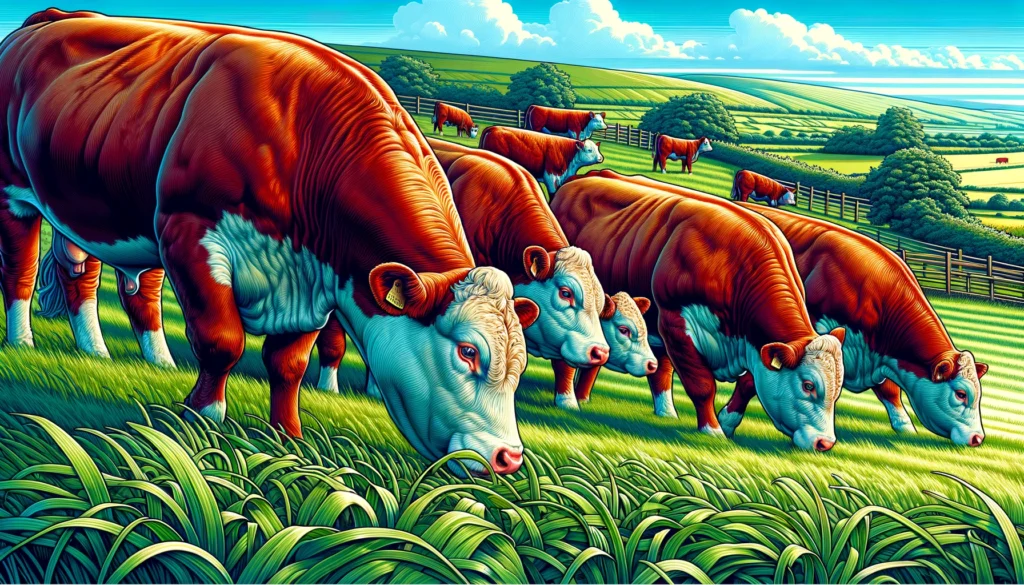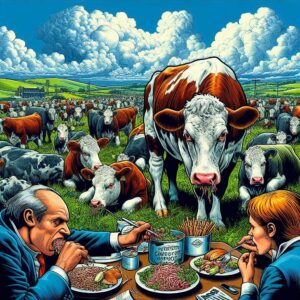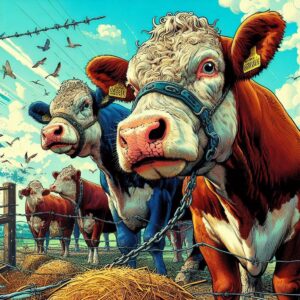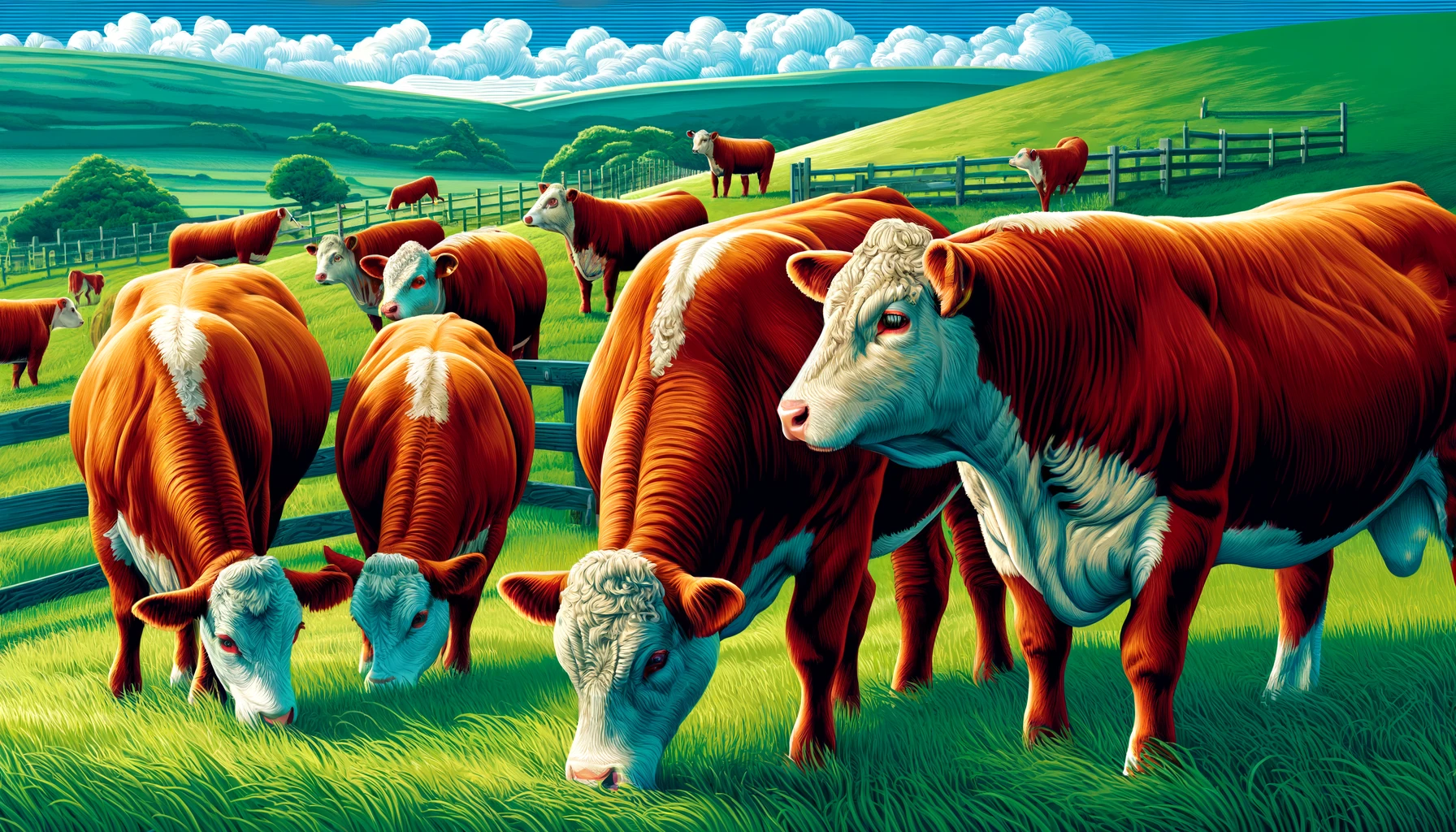Hereford Cattle: Status and Significance
Best Beef Cattle: Hereford Cattle
Hereford cattle are a popular breed of beef cattle known for their distinctive red and white coloration and robust build. Originating from Herefordshire, England, these cattle have become one of the most widely distributed breeds worldwide due to their adaptability, docile nature, and superior meat quality.
Historical Background
The Hereford breed was established in the early 18th century by farmers in Herefordshire who sought to develop a robust cattle breed capable of thriving in the region’s varied climate. The breed was officially recognized in 1846 with the formation of the Hereford Herd Book. By the late 19th century, Hereford cattle had been exported to many countries, including the United States, where they quickly gained popularity for their high yield of quality beef and ease of management.
Physical Characteristics
Hereford cattle are characterized by:
- Coloration: Red bodies with white faces, brisket, underside, and tail switch.
- Size: Medium to large build with mature bulls weighing between 1,800 to 2,400 pounds and cows between 1,200 to 1,600 pounds.
- Horned and Polled Variants: Originally horned, the breed now includes a significant polled (hornless) population due to selective breeding.
Adaptability and Distribution
One of the key strengths of Hereford cattle is their adaptability to diverse environmental conditions. They thrive in various climates, from temperate regions to more arid environments. This adaptability has facilitated their widespread distribution across continents, making them a preferred choice for beef production in countries such as the United States, Canada, Australia, and South America.
Economic Significance
Meat Quality
Hereford cattle are renowned for their high-quality beef, characterized by:
- Marbling: Well-distributed fat within the muscle, contributing to tenderness and flavor.
- Carcass Yield: High dressing percentage, making them economically advantageous for beef producers.
- Consistency: Reliable meat quality across different environmental conditions.
Breeding and Crossbreeding
Hereford cattle are also significant in the context of breeding programs. They are often used in crossbreeding to enhance traits such as:
- Disease Resistance: Herefords contribute to improved overall herd health.
- Growth Rates: Crossbreeding with other breeds can result in hybrid vigor, leading to faster growth rates and better feed efficiency.
Challenges and Considerations
Despite their many advantages, Hereford cattle face certain challenges:
- Inbreeding: Maintaining genetic diversity within the breed is essential to avoid inbreeding depression.
- Climate Change: Adapting to increasingly extreme weather conditions requires ongoing genetic selection for resilience.
- Market Competition: Competing with other popular beef breeds, such as Angus, necessitates continuous improvement in Hereford genetics and marketing strategies.
Hereford Cattle in Modern Agriculture
In modern agriculture, Hereford cattle continue to play a crucial role. They are a staple in sustainable beef production systems due to their:
- Low Maintenance: Ease of handling and management makes them suitable for both small and large-scale operations.
- Grass-Fed Systems: Excellent conversion of grass into high-quality beef, supporting sustainable and organic farming practices.
- Global Demand: Consistent demand for Hereford beef in international markets ensures their ongoing economic relevance.
Case Study: Hereford Cattle in the United States
The United States is a prime example of Hereford cattle’s significance:
- Population: Hereford cattle constitute a significant portion of the U.S. beef cattle population.
- Industry Support: Organizations like the American Hereford Association provide extensive support for breeders, including genetic testing, marketing, and educational resources.
- Innovation: U.S. Hereford breeders continually adopt new technologies and practices to enhance the breed’s performance and profitability.
Future Outlook
The future of Hereford cattle looks promising with advancements in:
- Genomics: Utilizing genetic tools to improve traits such as feed efficiency, disease resistance, and meat quality.
- Sustainability: Emphasizing sustainable breeding and management practices to meet environmental and consumer demands.
- Global Expansion: Continuing to explore and expand into new markets while maintaining high standards of meat quality and animal welfare.
Conclusion
Hereford cattle hold a prominent place in the global beef industry due to their adaptability, superior meat quality, and economic viability. As agriculture evolves, Hereford cattle will likely continue to be a key player in sustainable and efficient beef production systems.
Keywords
- Beef cattle
- Hereford breed
- Meat quality
- Crossbreeding
- Sustainable agriculture
How Knowledge of Hereford Cattle Can Help Farmers
Understanding the significance and status of Hereford cattle can help farmers make informed decisions about breeding, management, and marketing strategies. By leveraging the breed’s strengths and addressing its challenges, farmers can enhance productivity, meet market demands, and contribute to sustainable agricultural practices.

Helpful Content for Ranchers: Optimizing Hereford Cattle Management
Definition: Hereford Cattle Management
Hereford cattle management encompasses the practices and strategies employed by ranchers to ensure the health, productivity, and profitability of their Hereford herds. Effective management involves considerations of nutrition, breeding, healthcare, and marketing to maximize the benefits of raising Hereford cattle.
Nutritional Strategies for Hereford Cattle
Grass-Fed vs. Grain-Fed Systems
Ranchers can choose between grass-fed and grain-fed systems for raising Hereford cattle:
- Grass-Fed: Promotes natural grazing behavior and produces leaner beef with a distinct flavor profile. It supports sustainable practices and may attract a niche market of health-conscious consumers.
- Grain-Fed: Typically results in faster weight gain and higher marbling in beef, catering to mainstream consumer preferences. Requires careful management of feed quality and quantity to avoid health issues like acidosis.
Supplementation
Regardless of the primary feeding system, supplementation is crucial:
- Mineral and Vitamin Supplements: Ensure balanced nutrition, particularly in regions with nutrient-deficient soils.
- Protein Supplements: Important during periods of low forage quality to maintain growth rates and reproductive performance.
Breeding and Genetics
Selecting Superior Genetics
Ranchers can enhance their Hereford herds by:
- Artificial Insemination (AI): Allows access to superior genetics without the need to purchase high-cost breeding bulls. It also facilitates genetic diversity.
- Embryo Transfer (ET): Enables rapid multiplication of desired genetics, especially from elite females.
Crossbreeding Programs
Incorporating crossbreeding can improve herd performance:
- Hybrid Vigor: Crossbreeding Herefords with other breeds, such as Angus or Simmental, can result in offspring with enhanced growth rates, feed efficiency, and overall hardiness.
- Trait Selection: Focus on traits such as disease resistance, fertility, and carcass quality to meet specific market demands.
Health and Welfare
Preventative Healthcare
Implementing a comprehensive healthcare plan is vital:
- Vaccination Programs: Regular vaccination against common bovine diseases ensures herd health and productivity.
- Parasite Control: Effective management of internal and external parasites through deworming and insect control measures.
Welfare Practices
Maintaining high welfare standards is not only ethical but also enhances productivity:
- Stress Reduction: Minimize handling stress by using low-stress handling techniques and providing adequate shelter and comfort.
- Monitoring and Intervention: Regular health checks and prompt intervention for any signs of illness or injury.
Marketing and Economic Considerations
Direct Marketing
Exploring direct marketing avenues can enhance profitability:
- Farmers’ Markets: Selling directly to consumers at local markets can provide higher returns compared to traditional channels.
- Online Sales: Leveraging e-commerce platforms to reach a broader customer base.
Value-Added Products
Creating value-added products can diversify income streams:
- Processed Meats: Offering products such as jerky, sausages, and specialty cuts can attract niche markets.
- Agri-Tourism: Incorporating farm tours, farm stays, and educational workshops to generate additional revenue and promote the Hereford breed.
Case Study: Sustainable Hereford Ranching
A case study of a successful Hereford ranch:
- Location: Green Valley Ranch, Texas.
- Practices: Emphasizes rotational grazing, conservation practices, and direct marketing.
- Outcomes: Achieved high profitability and community recognition for sustainable practices and superior beef quality.
Future Trends in Hereford Cattle Ranching
Technological Advancements
Embracing technology can optimize ranching operations:
- Precision Agriculture: Using GPS and data analytics to manage grazing patterns and monitor herd health.
- Genomic Testing: Enhancing breeding decisions through detailed genetic information.
Market Trends
Staying informed about market trends ensures competitiveness:
- Consumer Preferences: Growing demand for grass-fed and organic beef.
- Regulations: Adapting to changes in food safety and animal welfare regulations.
Conclusion
Effective management of Hereford cattle involves a combination of nutritional strategies, genetic improvement, health and welfare practices, and innovative marketing approaches. By staying informed and adopting best practices, ranchers can maximize the productivity and profitability of their Hereford herds.
Hereford Beef Image Gallery




